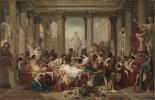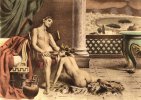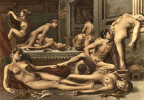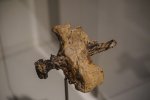malins
Stumbling Seeker
Anyway briefly poking around a bit in the literature ... some mentions spread around in this larger work
https://www.cambridge.org/core/serv...e_in_Roman_Imperial_Italy.pdf?event-type=FTLA
as well as some of the sources from the wiki article I guess observations are ...
The correlation of the numbers on the token and the sex acts shown varies,
The same numeral sides made from the same coin-stamping die are also found with non-sexual portraits, that are interpreted as members of the imperial family.
Also due to the extensive 'die-sharing' it's likely that all of the known spintriae where struck at the same location in a limited time frame.
The numbers can't correlate directly to the price of a certain act depicted as they are too variable and also the depictions show up on other objects such as oil lamps etc., it may well be that they were standards, almost like sexy pictograms.
In other words, the boring numbers might be more important than the pictures which might just be 'something fun to put on the other side' although that is of course a less titillating interpretation. Though again one shouldn't jump to the conclusion that the number directly reflects an inherent value or cost of the token.
One of the main inspriations that they are brothel tokens is this quote

It seems a bit strange then though that tokens produced from the same dies for the reverse, would have emperors on the obverse. That would be asking for trouble...
From a practical standpoint... exchanging your money for the token at the door of the brothel, then entering and paying with the token in the brothel, then the brothel converting its own token back to currency... not entirely convincing, the Romans were well aware of the idea of purchasing a service that might be delivered a few steps down the hall and a few minutes later.
well, maybe they could be gift vouchers or something but the whole conversion idea isn't as convincing in practice.
Perhaps if we had clear evidence that there was a strict cultural rule that "you must give coin to a prostitute directly", together with a ban on taking proper money into the brothel, then it would make sense.
Because if it's a token that she can't directly use as money, this would give the brothel owner the opportunity to sell her services at a higher price, and redeem the tokens she earned for less money. But I'm not aware of such a tradition.
Also one would have to consider, did one brothel owner go to the effort and cost of having these tokens made? Would other brothels accept the same tokens?
A very down to earth interpretation is basically as locker tokens outlined here, with a correlation of numerals and scenes
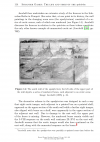
it seems somewhat plausible that there were reasonably standardized layouts for bathhouses built during a certain period and region, and that perhaps a single metalworking business might have produced a run of bronze tokens and marketed them to such bathhouses.
If you only had eight lockers insted of sixteen you'd just order a set of tokens running to eight.
That would explain also the variations of the associations of scenes and numbers - even if the sex scenes were based on widespread iconic imagery you couldn't expect every bathhouse to have the same scene associated with the same number.
Obviously unless we get more source information it's hard to tell.
A thing to be wary of though is the conclusion that because there's sexy scenes on them they have to do something with purchasing sex, when simply there was way more sexual imagery present in the Roman age than in the societies existing when the spintriae were first re-discovered.
Jumping to that conclusion right away may say more about the discovering culture than the one that produced them...
https://www.cambridge.org/core/serv...e_in_Roman_Imperial_Italy.pdf?event-type=FTLA
as well as some of the sources from the wiki article I guess observations are ...
The correlation of the numbers on the token and the sex acts shown varies,
The same numeral sides made from the same coin-stamping die are also found with non-sexual portraits, that are interpreted as members of the imperial family.
Also due to the extensive 'die-sharing' it's likely that all of the known spintriae where struck at the same location in a limited time frame.
The numbers can't correlate directly to the price of a certain act depicted as they are too variable and also the depictions show up on other objects such as oil lamps etc., it may well be that they were standards, almost like sexy pictograms.
In other words, the boring numbers might be more important than the pictures which might just be 'something fun to put on the other side' although that is of course a less titillating interpretation. Though again one shouldn't jump to the conclusion that the number directly reflects an inherent value or cost of the token.
One of the main inspriations that they are brothel tokens is this quote

It seems a bit strange then though that tokens produced from the same dies for the reverse, would have emperors on the obverse. That would be asking for trouble...
From a practical standpoint... exchanging your money for the token at the door of the brothel, then entering and paying with the token in the brothel, then the brothel converting its own token back to currency... not entirely convincing, the Romans were well aware of the idea of purchasing a service that might be delivered a few steps down the hall and a few minutes later.
well, maybe they could be gift vouchers or something but the whole conversion idea isn't as convincing in practice.
Perhaps if we had clear evidence that there was a strict cultural rule that "you must give coin to a prostitute directly", together with a ban on taking proper money into the brothel, then it would make sense.
Because if it's a token that she can't directly use as money, this would give the brothel owner the opportunity to sell her services at a higher price, and redeem the tokens she earned for less money. But I'm not aware of such a tradition.
Also one would have to consider, did one brothel owner go to the effort and cost of having these tokens made? Would other brothels accept the same tokens?
A very down to earth interpretation is basically as locker tokens outlined here, with a correlation of numerals and scenes

it seems somewhat plausible that there were reasonably standardized layouts for bathhouses built during a certain period and region, and that perhaps a single metalworking business might have produced a run of bronze tokens and marketed them to such bathhouses.
If you only had eight lockers insted of sixteen you'd just order a set of tokens running to eight.
That would explain also the variations of the associations of scenes and numbers - even if the sex scenes were based on widespread iconic imagery you couldn't expect every bathhouse to have the same scene associated with the same number.
Obviously unless we get more source information it's hard to tell.
A thing to be wary of though is the conclusion that because there's sexy scenes on them they have to do something with purchasing sex, when simply there was way more sexual imagery present in the Roman age than in the societies existing when the spintriae were first re-discovered.
Jumping to that conclusion right away may say more about the discovering culture than the one that produced them...






